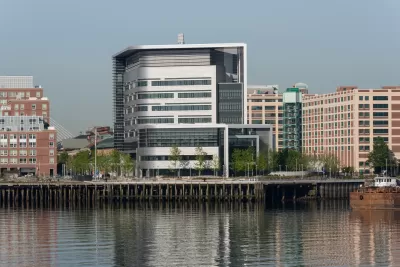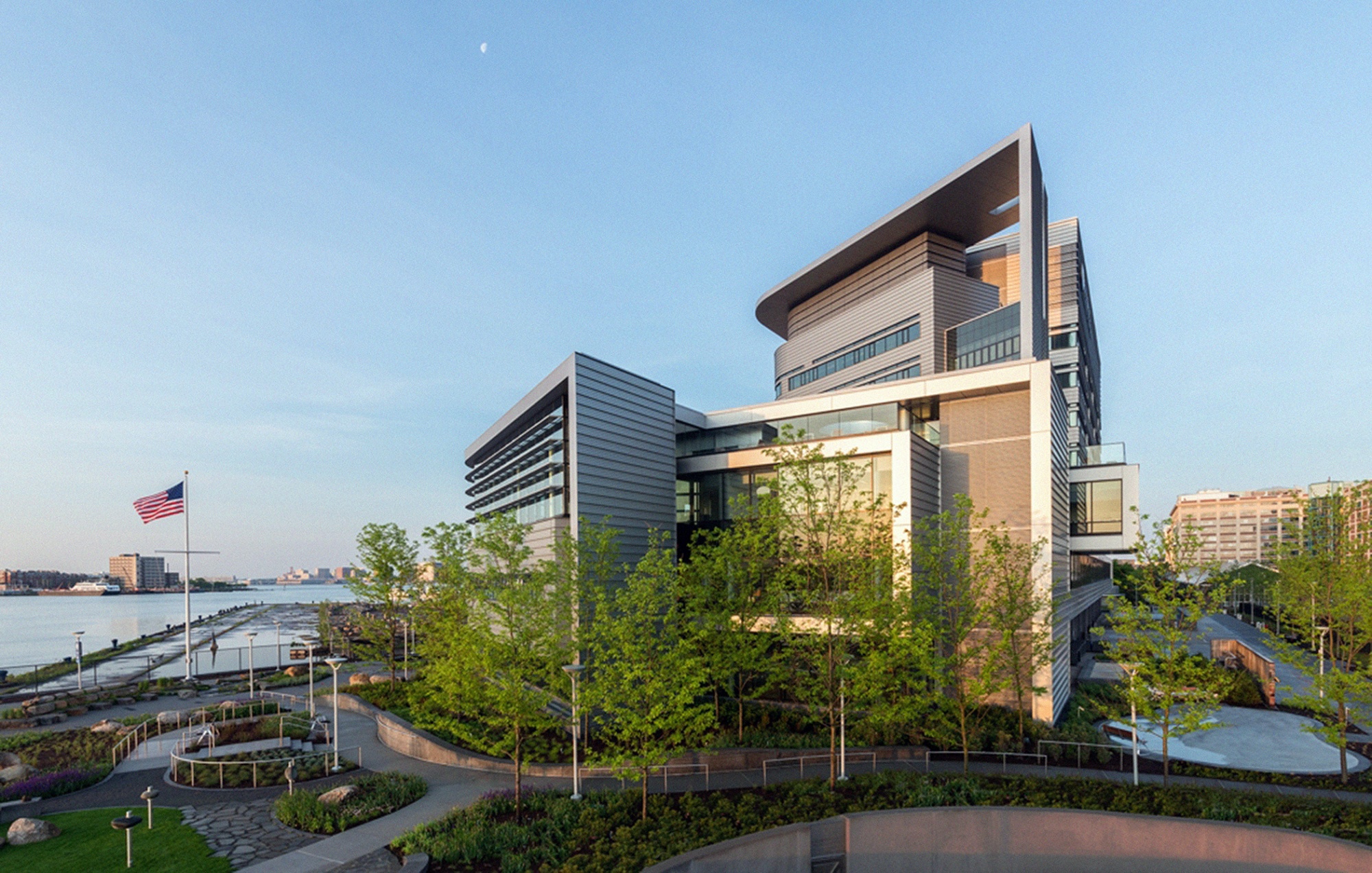The Urban Land Institute (ULI) is showing developers how resilience can benefit the bottom line in the "Returns on Resilience" report. Sarene Marshall, director of the ULI Center for Sustainability, offers insight into the report's examples.

Katrina. Sandy. Joaquin. Patricia. If it seems to you that weather-related disasters are on the rise, you're not mistaken: the number of such disasters in North America has nearly quintupled since 1980. That's because a changing climate brings more extreme weather, and because more people and property are in harm's way than ever before.
These disasters—from drought and wildfires to hurricanes and flooding—are spurring forward-thinking architects and developers to "build for resilience." A new report from the Urban Land Institute (ULI) shows that building for resilience makes sense for people, for the planet—and for the bottom line.
Building for resilience means following emerging best practices in land use, design, and construction to protect buildings—and their inhabitants—from climate risks. The ULI report, Returns on Resilience: The Business Case offers ten case studies of projects that have adopted this approach.
Consider, for example, the Spaulding Rehabilitation Hospital in Boston. When Partners Healthcare set out to build the new hospital a decade ago, it chose a site on the Boston waterfront, where patients could engage in water sports, including kayaking, as part of their rehab program. But, just as planning began, Hurricane Katrina struck New Orleans and dozens of patients died in that city's hospitals because of flooding and systems failures—a catastrophe that forced Spaulding to rethink the project.

Determined to prevent a similar disaster, the Partners team built Spaulding to withstand intense storms, flooding, and power loss. They raised the hospital's first floor well above the 500-year flood level, and all mechanicals—boilers, chillers, air handlers—are installed in a penthouse so they can operate during a flood. Backup generators are fueled by diesel from a flood-proof vault.
Importantly, the building is designed to save energy, so it's easier to provide backup power when the grid goes down. High-efficiency mechanicals, a gas-fired "cogeneration" system, and a super-insulated building envelope reduce Spaulding's energy use to half that of comparable facilities.

Resilience measures raised the cost of the project—adding $1.5 million to the hospital's $225 million price tag. But the investments quickly paid for themselves. Nearly half the cost was offset by utility company rebates. And energy efficiency shaves $500,000 a year off the hospital's operating costs. Moreover, resilience measures have contributed to a beautiful, comfortable building that offers priceless peace of mind to patients and staff. Perhaps as a result, Spaulding has a long waiting list of patients seeking treatment.
 Spaulding's experience is not unique. Case studies in the ULI report include 1450 Brickell (pictured left), a Miami office tower built to withstand hurricane-force winds and flying debris. The building's high-tech glass windows also deflect heat—saving the building owners $1 million a year on electrical costs. Resilience measures—including two backup generators—help explain why 1450 Brickell was quickly fully leased, while comparable properties remained only half occupied.
Spaulding's experience is not unique. Case studies in the ULI report include 1450 Brickell (pictured left), a Miami office tower built to withstand hurricane-force winds and flying debris. The building's high-tech glass windows also deflect heat—saving the building owners $1 million a year on electrical costs. Resilience measures—including two backup generators—help explain why 1450 Brickell was quickly fully leased, while comparable properties remained only half occupied.
As shown by the previous examples, and the others included in the ULI report, sustainability and resilience make good partners. Design and construction choices that can qualify a project for LEED certification do double duty for resilience and triple duty for the project's bottom line. Sturdy, insulated building shells protect against storms while saving energy and reducing electricity bills. Installing green roofs, recycling graywater, and using cisterns can help conserve precious water during historic droughts and generate regular savings on water bills. Sustainability and resilience efforts, working in tandem, can reduce a project's negative effect on the environment, including curbing climate-changing greenhouse gas emissions.
At the same time, resilience makes a property more attractive. Projects built and maintained with resilience in mind enjoy greater marketing, sales, and leasing success. More resilient projects also benefit from better financing options, more competitive insurance rates, greater long-term savings on maintenance, and higher overall value compared to more vulnerable properties.
And yet—despite all of these advantages—building for resilience is not yet standard operating procedure in the United States. Why not?
Building codes are one issue. City planning and construction codes evolve slowly; they often reflect historic dangers rather than emerging threats. But, in a changing climate, "building to code" might not be enough to safeguard people and property.
And, among builders, planners, and investors, there are still many who take a short-sighted view of building costs. Yes, building for resilience entails greater up-front expenditures. But those costs are quickly recouped, and the payback—in protection and profits—is enormous.
That's why, as we face an uncertain future in a changing climate, there is no reason not to build for resilience.
[1450 Brickell image courtesy of 1450 Brickell.]


Trump Administration Could Effectively End Housing Voucher Program
Federal officials are eyeing major cuts to the Section 8 program that helps millions of low-income households pay rent.

Planetizen Federal Action Tracker
A weekly monitor of how Trump’s orders and actions are impacting planners and planning in America.

Canada vs. Kamala: Whose Liberal Housing Platform Comes Out on Top?
As Canada votes for a new Prime Minister, what can America learn from the leading liberal candidate of its neighbor to the north?

Washington State’s Parking Reform Law Could Unlock ‘Countless’ Acres for New Housing
A law that limits how much parking cities can require for residential amd commercial developments could lead to a construction boom.

Wildlife Rebounds After the Eaton Fire
Following the devastation of the Eaton Fire, the return of wildlife and the regrowth of native plants are offering powerful signs of resilience and renewal.

LA to Replace Inglewood Light Rail Project With Bus Shuttles
LA Metro says the change is in response to community engagement and that the new design will be ready before the 2028 Olympic Games.
Urban Design for Planners 1: Software Tools
This six-course series explores essential urban design concepts using open source software and equips planners with the tools they need to participate fully in the urban design process.
Planning for Universal Design
Learn the tools for implementing Universal Design in planning regulations.
Central Transportation Planning Staff/Boston Region MPO
Heyer Gruel & Associates PA
Institute for Housing and Urban Development Studies (IHS)
City of Grandview
Harvard GSD Executive Education
Regional Transportation Commission of Southern Nevada
Toledo-Lucas County Plan Commissions





























